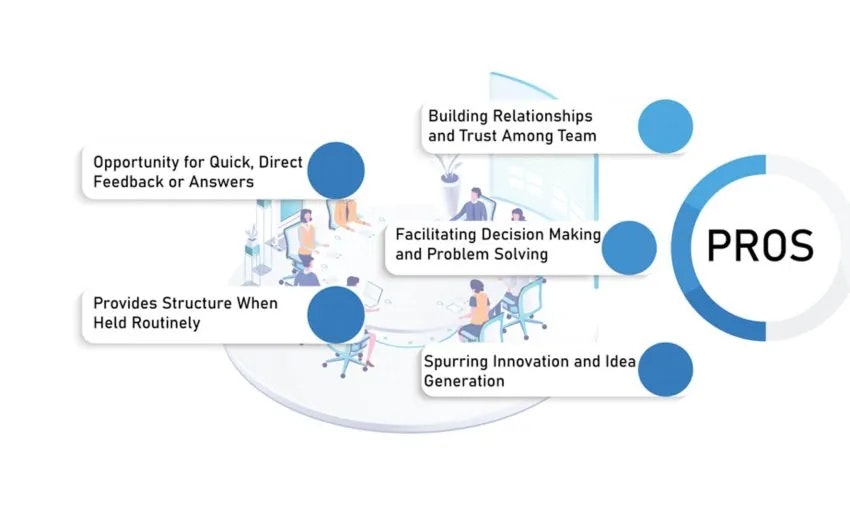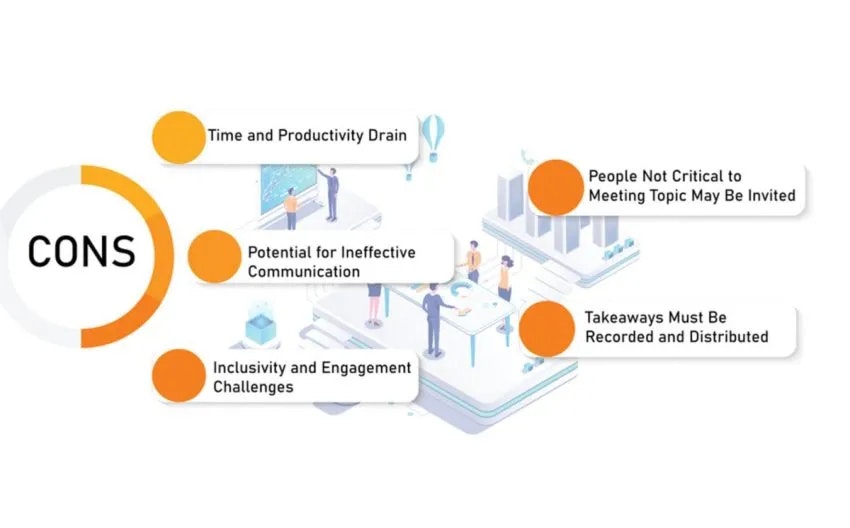CSD Pool HR Series: The Pros And Cons Of Meetings

February 2, 2024 | CSD Team
Meetings are a cornerstone of organizational communication, serving as a platform for collaboration, decision-making, and knowledge-sharing.
When conducted effectively, they can foster creativity and productivity, driving progress towards common goals. However, not all meetings are created equal, and their frequency and execution can be a double-edged sword.
In this article, we will explore the merits and drawbacks of holding meetings within your organization, addressing the ‘why’, ‘when’, ‘how’, and offering best practices for optimizing this crucial aspect of business operations.
‘Why’ and ‘When’ We Have Meetings
The ‘Why’ of Meetings
For an effective meeting to happen, it’s necessary to understand what the reason for meetings are.
One reason to hold a meeting is to enhance communication and collaboration. Meetings provide a structured platform for staff to exchange ideas, discuss progress, and clarify doubts. This promotes real-time communication and interaction that encourages collaboration.
Meetings facilitate open discussions where team members can share diverse perspectives, contributing to a richer pool of ideas. Colleagues can brainstorm, problem-solve, and leverage each other’s expertise, creating a collaborative environment. A collaborative environment helps build trust, enhances teamwork, and ultimately leads to a more effective and innovative workplace.
Another reason for meetings is to foster a sense of inclusion and team cohesion. When the team gets together for a meeting, people feel a sense of inclusion in the workplace. Not only is it great for an individual’s sense of purpose at work, but it’s also great for building a sense of collective purpose. Through these conversations in meetings, team members gain a clearer understanding of their collective purpose and larger objectives they are working towards.
Lastly, a meeting can be held to align goals and objectives within the group. The shared vision they have fosters a sense of unity and commitment, aligning individual efforts with the broader goals of the team or organization.
Regular reinforcement of this purpose in meetings helps build a cohesive and motivated team.
The ‘When’ of Meetings
Now that we know the purpose of meetings, it is important to know when meetings should happen.
Scheduled meetings are beneficial for routine updates, project planning, and discussing predetermined topics. They provide structure and ensure that team members allocate time for collaboration.
Ad-hoc, or, “on-the-fly” meetings are suitable for addressing urgent matters, quick discussions, or spontaneous problem-solving. This also promotes flexibility and responsiveness. The choice between the two depends on the nature of the discussion and level of planning or spontaneity required.
Next, the frequency and duration of meetings should be determined based on the team’s needs, the nature of the work, and the goals of the meeting. Regular check-ins, like weekly or bi-weekly meetings can help maintain that communication and collaboration.
For project planning or detailed discussions, longer sessions may be necessary. Consider the complexity of topics, ensuring meetings are long enough for meaningful discussion, but not so lengthy they become unproductive. Flexibility is key—adjust frequency and duration based on the evolving priorities and feedback from the team.
Lastly, when scheduling meetings, it is important to keep in mind everyone’s time zones for the virtual meetings, as well as everyone’s availability.
As the workplace has become more remote and flexible, not everyone is available at the typical times. Consider selecting a time that accommodates the majority of participants and avoids extremely early or late hours. Use tools that display multiple time zones to find a suitable overlap. Also, rotating meeting times periodically to share the inconvenience across team members can help. Additionally, solicit input on availability. Finally, strive for inclusivity and communication well in advance to allow participants to plan accordingly.
Choosing the Right Format (In-person, Virtual, Hybrid)
Technology has made available a whole host of meeting options, so be sure to consider carefully which type works best for your time while planning.
In person meetings are pretty self-explanatory; everyone gets together in one place, face-to-face, for the meeting. This works well for teams that aren’t far from each other and these meetings are common in office settings. Meeting in person can be a good way to build relationships between team members, but this approach isn’t feasible if you have people who live too far away from the meeting location to reasonably be able to travel there.
Virtual meetings take place using some kind of technological communication (Zoom, Microsoft Teams, etc.). In a virtual meeting, everyone attends from their own home or workspace. This type of meeting can work well for teams separated by distance as team members can attend even if they’re scattered across the world.
However, it can be difficult for people to stay engaged or build relationships with other team members when attending a virtual meeting. These meetings are also heavily dependent on the technology being used, so any sort of technical issues can completely throw a meeting into disarray.
Hybrid meetings attempt to combine the best aspects of both of these approaches: there is an assigned meeting location for people to talk with each other in person, but there is also a virtual meeting open for people who are unable to be there. This approach both ensures that everyone is able to attend the meeting and provides an opportunity for those who are able to come to see their team in person.
However, there are a number of drawbacks to this type of meeting. Just like with virtual meetings, issues with technology can bring the meeting to a standstill.
It can also be difficult for team members to interact between mediums, especially if there’s multiple people joining in virtually. Some team members may not be able to hear when others are speaking, and the conversation can be difficult to follow.
Finally, hosting a hybrid meeting means that the location where people are meeting in person must be able to support your virtual team members.
This doesn’t have to be elaborate, but at the very least you’ll want to be sure the room has a place to charge the laptop that will be hosting the virtual meeting.
Setting Clear Agendas and Objectives
When planning a meeting, it’s important to determine what your goals are for the meeting. At the very least, you should have the answers to the following questions prepared:
Is there an overall goal to your meeting (building team relationships, clearing up confusion on a problem, planning for an event, etc.)?
- What is your team going to talk about at this meeting?
- In what order are they going to talk about these things?
- What needs to be done by the end of the meeting?
Once you know the answer to these questions, you can compile the list of what will be discussed into a document called an agenda. We’ll cover agendas in more detail when discussing best practices.
Utilizing Technology and Tools for Effective Meetings
Be sure to consider if there is any other tool or technology that would help your meeting run more smoothly. Maybe using PowerPoint presentations or paper handouts could help everyone visualize the information you’re going over.
If you’re short for time, use your phone or a timer to allot a certain amount of time for each topic. There’s an endless number of ways to enhance your meeting, but—regardless of what tool you use—the key is to have it ready in advance.
The Pros of Holding Meetings

There’s a reason that meetings exist in the first place, they’re useful! An effective meeting can do a lot for your team, including…
Facilitating Decision Making and Problem Solving
Meetings provide excellent opportunities for making decisions or solving problems that the team is dealing with. While a normal workday might have everyone spread out across the office, meetings get everyone in one place to give their input and share what information they have that might be relevant to the issue.
There’s no delay in getting responses back from team members when questions are asked and—if everything is done right—everyone on the team will leave knowing what the next steps are.
Spurring Innovation and Idea Generation
It’s easy to get wrapped up in the day-to-day work and not want to be bothered with a meeting. However, having everyone together for a meeting allows team members to build off each other’s ideas and even come up with new ones.
The saying, “two heads are better than one” really rings true! If the conversation is flowing, your team could stumble upon their next big project and find ways to improve things that they never would have come up with on their own.
Building Relationships & Trust Among Team Members
It’s one thing to learn your coworkers’ names, but learning who they are as people can sometimes be challenging. Meetings can provide a space for talking or team-building activities (although this depends on the goal of the meeting and how much time is available).
Knowing more about your team members than what they do on the job lays the foundation for trust and a better working relationship.
The Cons of Holding Meetings

Time and Productivity Drain
No matter how successful a meeting is, the fact remains that every minute your team members spend in a meeting is a minute they are not able to spend doing their jobs. And that’s assuming the best of a meeting! If it’s already poorly organized or pointless you’ve effectively wasted the time and energy of everyone who attended.
While meeting with your team can be useful for maintaining communication, it’s important to recognize that scheduling meetings will always take time that could be used for other things. Ultimately, it’s up to you to make the judgment call for if that drain on time and productivity is worth it for the meeting.
Potential for Ineffective Communication
Unfortunately, effective communication isn’t just a matter of getting everyone in the same room. We’ve all been in conversations before where something was misinterpreted or left out, and the result is often utter confusion at what was even being discussed before.
Meetings require that team members respond and answer questions in real time, meaning that there’s no time to really think about what is being said and omit unnecessary or confusing details. Sometimes you really might just be better off sending an email.
Inclusivity and Engagement Challenges
Depending on your team, getting everyone actively engaged and participating in the meeting can be challenging. Some people simply aren’t comfortable in a meeting environment or able to participate in the same way as others, and that makes it too easy for their voices to get lost in the noise.
Others may be incredibly eager to participate but not realize that they are not leaving room for others to join in on the conversation. Work meetings are a social experience, and it’s all too possible for members of your team to leave feeling dejected and left out.
Best Practices for Effective Meetings
Preparing and Distributing Agendas in Advance
Agendas are an incredibly useful tool for conducting effective team meetings. First, the act of preparing the agenda will help you gauge how important it is to hold the meeting; is there a great deal to talk about, or has it been a slow week? If you’re scheduling meetings as needed, preparing an agenda will help you ensure that every meeting you hold counts.
Sending out the agenda before the meeting also helps set your team members’ expectations of what will be discussed. This makes it easier to keep the conversation productive and bring people back on track if things do spiral.
Finally, you can use the agenda to evaluate your meeting once it has ended. Did you cover everything that was on the agenda? If not, you know exactly what you missed and can take steps towards making sure that information is still conveyed to the team.
Encouraging Active Participation and Feedback
Meetings run the risk of falling flat when they are one-sided. Encouraging active participation and feedback in meetings involves creating an inclusive environment where team members feel comfortable expressing their thoughts.
Employ strategies such as posing open-ended questions, actively seeking diverse opinions, and acknowledging and appreciating contributions. Utilize collaborative tools or techniques, such as brainstorming sessions or breakout discussions, to engage team members and generate ideas collectively. This approach fosters a culture of open dialogue and ensures that various perspectives are considered, enhancing overall participation during meetings.
Beyond that, implementing follow-up actions and accountability measures is crucial for translating meeting discussions into tangible outcomes. Start by establishing clear objectives and assigning responsibilities during the meeting.
Document key decisions, action items, and deadlines, and promptly circulate these meeting minutes to all participants. Create a systematic approach for regular progress updates, either through follow-up emails or dedicated agenda items in subsequent meetings.
By consistently revisiting action items and holding team members accountable, you establish a framework for tracking progress and maintaining momentum on initiatives discussed during meetings.
Deciding How to Meet
In conclusion, while meetings play a vital role in fostering communication, collaboration, and decision-making in a professional workplace, they are not without their challenges. The pros of meetings include the opportunity for real-time interaction, idea exchange, and team building.
On the flip side, the cons encompass issues such as time inefficiency, potential for disengagement, and the risk of overshadowing individual productivity. Striking a balance between leveraging the benefits of meetings and mitigating their drawbacks is essential.
Employing effective meeting management strategies, embracing technology to enhance efficiency, and fostering a culture of purposeful and inclusive discussions can help organizations maximize the positive impact of meetings while minimizing potential drawbacks.
Ultimately, a thoughtful and strategic approach to meetings can contribute significantly to a productive and collaborative professional environment.
For more HR information and resources, visit our site HR.
